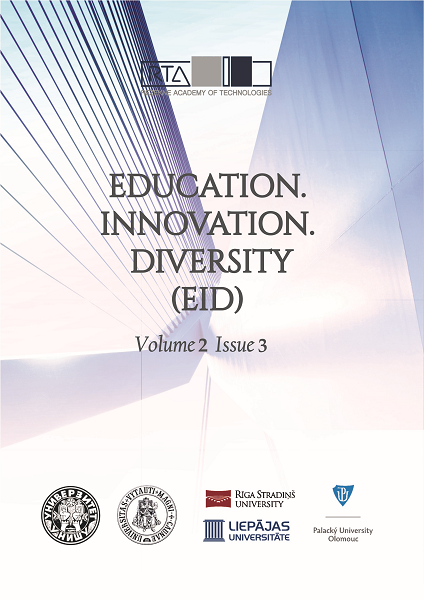PREFERENCES FOR VIRTUAL MUSIC THERAPY AND THE USE OF TECHNOLOGY IN THE PRACTICE OF CZECH MUSIC THERAPISTS – A DESCRIPTIVE CROSS-SECTIONAL STUDY
DOI:
https://doi.org/10.17770/eid2021.2.6708Keywords:
Music therapy, virtual, telehealth, pandemic, survey, ICT, COVIDAbstract
The preventive restrictions imposed at the beginning of March 2020 led to the interruption of the therapeutic practice of most music therapists in the Czech Republic. The aim of this descriptive cross-sectional study was to find out what impact this situation had on the music therapy community at the end of May 2020, how many music therapists gained experience with virtual music therapy (VMT) and how ICT and other technologies were used in music therapy practice. A survey with an extended version of a questionnaire created by Gilboa, Weiss and Dassa (not yet published) for the purpose of an international survey in music therapy was used for data collection. Based on the findings, most music therapists at the time had no experience with VMT, but a small number of practitioners were interested in using VMT even after the end of the lockdown. ICT has been used more for receptive music therapy activities and its wider application faces problems such as a lack of knowledge and skills in the use of ICT in the context of music therapy. Based on these findings, a project focused on the implementation of best-evidence concerning VMT into Czech music therapy practice was launched. Also, we recommend creating projects focused on the use of ICT (including applications in music therapy conducted face-to-face) in the near future.
References
Berman, A. (2020, December 20). Music Connects Us: The Use of Music and the Role of Music Therapy during a Pandemic Crisis Situation EMTC. Retrieved from . https://www.emtc-eu.com/
Fuller, A. M., & McLeod, R. G. (2019). The Connected Music Therapy Teleintervention Approach (CoMTTA) and its application to family-centred programs for young children with hearing loss. Australian Journal of Music Therapy, 30, 12-30.
Gaddy, S., Gallardo, R., McCluskey, S., Moore, L., Peuser, A., Rotert, R., Stypulkoski, C., & LaGasse, A.B. (2020). COVID-19 and Music Therapists’ Employment, Service Delivery, Perceived Stress, and Hope: A Descriptive Study. Music Therapy Perspectives. 38, 157–166. https://doi.org/10.1093/mtp/miaa018
Kantor, J. et al. (2016). Společné a rozdílné v uměleckých kreativních terapiích. Palacky University Olomouc.
Kantorová, L., Kantor, J., Hořejší, B., Gilboa, A., Svobodová, Z., Lipský, M., Marečková, J., & Klugar, M. (2021). Adaptation of Music Therapists’ Practice to the Outset of the COVID-19 Pandemic—Going Virtual: A Scoping Review. International Journal of Environmental Research and Public Health, 18(10), 5138. https://doi.org/10.3390/ijerph18105138
Knott, D., & Block, S. (2020). Virtual Music Therapy: Developing New Approaches to Service Delivery. Music Therapy Perspectives, 38(2), 151–156.
https://doi.org/10.1093/mtp/miaa017
Koucun, J., & Kantor, J. (2016). Modifications of cybernetic musical instrument CYMIS for creative rehabilitation and music education of persons with disabilities. In Proceedings of the 10th International Technology, Education and Development Conference. IATED. Retrieved from https://library.iated.org/view/KANTOR2016MOD
Lightstone, A.J., Bailey, S.K., & Voros, P. (2015). Collaborative music therapy via remote video technology to reduce a veteran's symptoms of severe, chronic PTSD. Arts health, 7(2),123-136. https://doi.org/10.1080/17533015.2015.1019895
Negrete, B. (2020). Meeting the Challenges of the COVID-19 Pandemic: Virtual developmental music therapy class for infants in the neonatal intensive care unit. Pediatric Nursing, 46(4), 198.
Vaudreuil, R., Langston, D.G., Magee, W.L., Betts, D., Kass, S., & Levy, C. (2020). Implementing music therapy through telehealth: considerations for military populations. Disability and Rehabilitation, 1-10. https://doi.org/10.1080/17483107.2020.1775312
Vilímek, Z., Kantor, J., & Kořínková, J. (2021). The Impact of Vibroacoustic Therapy on Subjective Perception of University Students – Mixed Design Pilot Study. Universal Journal of Educational Research, 9(7), 1409-1420. https://doi.org/10.13189/ujer.2021.090707
World Health Organisation. (2021, August, 30). COVID-19 Strategic Preparedness and Response Plan. Retrieved from https://www.who.int/publications/i/item/WHO-WHE-2021.02






